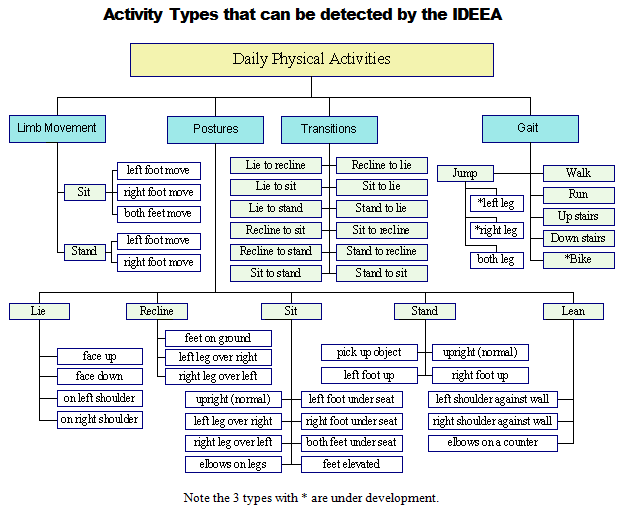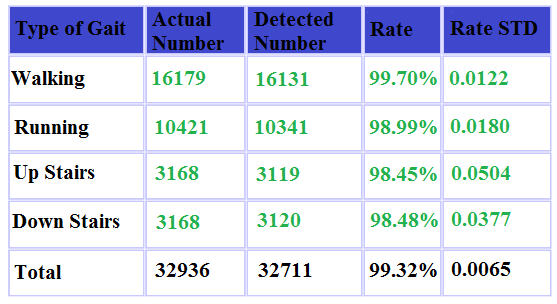|
|
 No other device can identify more than 10 types of activities, while IDEEA®
can identify and differentiate more than 40 types of activities accurately,
including most activities of daily living (ADL) that are important for obesity,
rehabilitation, osteoporosis, and many other studies.
No other device can identify more than 10 types of activities, while IDEEA®
can identify and differentiate more than 40 types of activities accurately,
including most activities of daily living (ADL) that are important for obesity,
rehabilitation, osteoporosis, and many other studies.
 All other
devices tell you the vibration sensed by the sensor(s) attached to the part of
body. Thus a child's waving hand can generate more signals than an adult
climbing stairs, which is not correct in terms of energy expenditure or
exercise level. IDEEA® uses advanced algorithms such as artificial intelligence
and neural network that integrates signals from multiple sensors of different
body parts to derive intelligently the exact type of activity the person is
performing (sitting, standing, jumping, stair climbing/descending...) with the
highest possible accuracy (a study by Dr. Pi-Sunyer’s group from Columbia
University showed average accuracy > 98.5% for 76 subjects studied). All other
devices tell you the vibration sensed by the sensor(s) attached to the part of
body. Thus a child's waving hand can generate more signals than an adult
climbing stairs, which is not correct in terms of energy expenditure or
exercise level. IDEEA® uses advanced algorithms such as artificial intelligence
and neural network that integrates signals from multiple sensors of different
body parts to derive intelligently the exact type of activity the person is
performing (sitting, standing, jumping, stair climbing/descending...) with the
highest possible accuracy (a study by Dr. Pi-Sunyer’s group from Columbia
University showed average accuracy > 98.5% for 76 subjects studied).
|
|
|
|
|
 The results such as power, mechanical work, and energy expenditure
measurement were calibrated by the most accurate whole-room calorimeters and the largest precision force platform, and validated on hundreds of tests in multiple clinical studies, thus has much higher accuracy and accountability. The results such as power, mechanical work, and energy expenditure
measurement were calibrated by the most accurate whole-room calorimeters and the largest precision force platform, and validated on hundreds of tests in multiple clinical studies, thus has much higher accuracy and accountability.
 IDEEA® measures and records millions of data points so that every slight movement or activity is recorded and saved for later use. While other devices only record an average of vibrations for a given period (say, on 1-minute intervals). IDEEA® measures and records millions of data points so that every slight movement or activity is recorded and saved for later use. While other devices only record an average of vibrations for a given period (say, on 1-minute intervals).
 IDEEA® is designed from ground-up by researchers conducting clinical studies. It presents the information a researcher needs, such as the type of
activities of daily living (ADL), it’s onset, duration, frequency, intensity (e.g., speed of walking or running), mechanical power generated, and related energy cost. Others output a number or a few numbers in a given time period that basically tells the level of sensor vibration. IDEEA® is designed from ground-up by researchers conducting clinical studies. It presents the information a researcher needs, such as the type of
activities of daily living (ADL), it’s onset, duration, frequency, intensity (e.g., speed of walking or running), mechanical power generated, and related energy cost. Others output a number or a few numbers in a given time period that basically tells the level of sensor vibration.
 Perhaps the most important difference is that the software that comes with IDEEA® enables you to play back the animation of what actually happened for the subject (e.g., At exactly what time a subject fell on the ground? What was the last supporting leg before falling? And many more) at any given time. The playback speed can be changed from 1:1 to 1:60 to speed up viewing. Graphs, charts, tables, and statistics are designed for scientific view and can be shown for any selected time period dynamically, printed out, or saved to a database of your own...... Perhaps the most important difference is that the software that comes with IDEEA® enables you to play back the animation of what actually happened for the subject (e.g., At exactly what time a subject fell on the ground? What was the last supporting leg before falling? And many more) at any given time. The playback speed can be changed from 1:1 to 1:60 to speed up viewing. Graphs, charts, tables, and statistics are designed for scientific view and can be shown for any selected time period dynamically, printed out, or saved to a database of your own......
 The device is perfect for activities
of daily living (ADL) such as household work, yard work, walking, jogging, and other aerobic exercises, and for quantifying sedentary lifestyle such as home, office, school environment. The distance traveled, the speed, related EE, the time period a person is sitting, standing, reclining, or sleeping, can all be measured, whether he/she is at work, home, or during exercise or transportation. Since there is no need for individual calibration, one set of device can be used for multiple patients during different days. The device is perfect for activities
of daily living (ADL) such as household work, yard work, walking, jogging, and other aerobic exercises, and for quantifying sedentary lifestyle such as home, office, school environment. The distance traveled, the speed, related EE, the time period a person is sitting, standing, reclining, or sleeping, can all be measured, whether he/she is at work, home, or during exercise or transportation. Since there is no need for individual calibration, one set of device can be used for multiple patients during different days.
|
|
|



